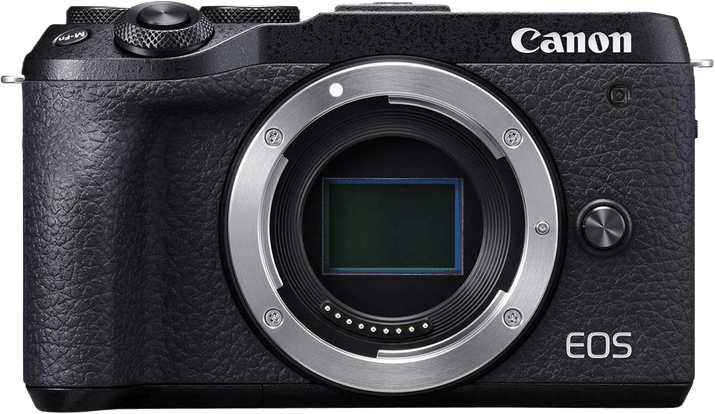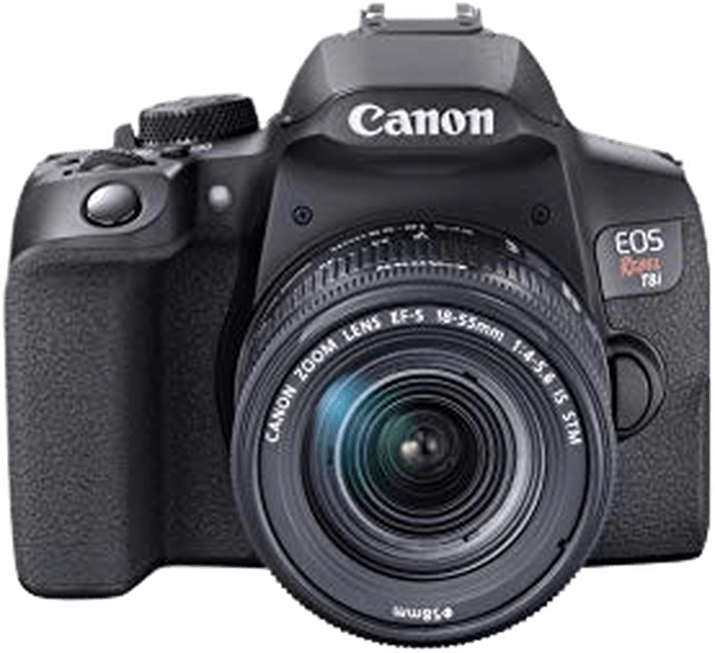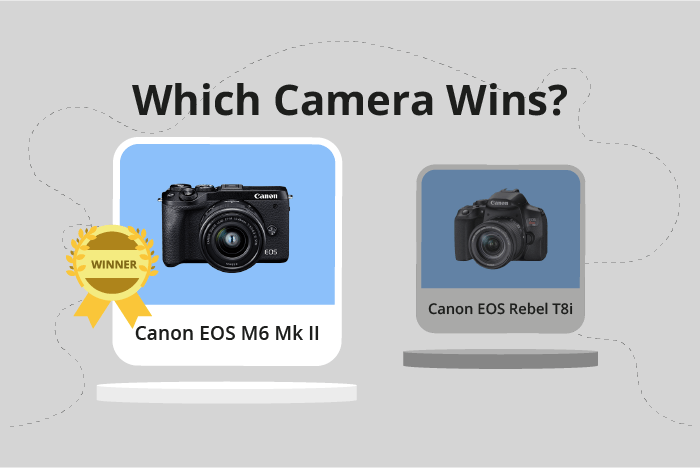Canon EOS M6 Mark II vs EOS Rebel T8i / 850D Comparison
Canon EOS M6 Mark II

Canon EOS Rebel T8i / 850D

The Canon EOS M6 Mark II emerges as the winner with a score of 63/100, while the Canon EOS Rebel T8i / 850D scores slightly lower at 59/100. Both cameras are from Canon and were released in 2019 and 2020, respectively. They share similarities in specifications, such as being launched at affordable prices ($850 for the M6 Mark II and $750 for the T8i / 850D).
The M6 Mark II stands out due to its compact size (120 x 70 x 49mm) and lightweight design (408g / 0.90lbs), making it more portable and convenient for users. On the other hand, the T8i / 850D is slightly larger (131 x 103 x 76mm) and heavier (515g / 1.14lbs), which might be preferred by those who appreciate a more substantial feel in their hands.
Taking into account the specifications and scores, the Canon EOS M6 Mark II is the better choice for those seeking a compact and lightweight camera, while the Canon EOS Rebel T8i / 850D caters to those who prefer a more traditional DSLR feel.
Canon EOS M6 Mark II vs EOS Rebel T8i / 850D Overview and Optics
The Canon EOS M6 Mark II wins the optics comparison with a score of 62/100, while the Canon EOS Rebel T8i / 850D receives a score of 57/100. Both cameras share several specifications, such as a CMOS sensor, Digic 8 processor, APS-C sensor size, and no image stabilization feature. Additionally, both cameras have the same DXOMARK score for the sensor at 58.
The EOS M6 Mark II outperforms the Rebel T8i in terms of megapixels and shooting speed. With 33 megapixels, it captures more details in images compared to the 24-megapixel Rebel T8i. The M6 Mark II also boasts a faster shooting speed of 14 frames per second (fps) compared to the Rebel T8i’s 7.5 fps. This faster speed allows the M6 Mark II to capture fast-moving subjects more efficiently.
Although the Rebel T8i has a lower score, it does have a better lens mount with the Canon EF/EF-S, which offers a wider range of compatible lenses compared to the M6 Mark II’s Canon EF-M mount. This advantage provides the Rebel T8i with more flexibility in terms of lens choices and creative options.
In conclusion, the Canon EOS M6 Mark II has superior optics performance due to its higher megapixels and faster shooting speed. However, the Canon EOS Rebel T8i / 850D offers more lens compatibility with its EF/EF-S mount, making it a viable option for those who prioritize flexibility in lens choice.
Canon EOS M6 Mark II vs EOS Rebel T8i / 850D Video Performance
The Canon EOS M6 Mark II emerges as the winner for video capabilities, scoring 91/100, while the Canon EOS Rebel T8i / 850D scores 83/100. Both cameras share some common specifications, such as 4K max video resolution, 3840 x 2160 max video dimensions, and built-in time-lapse functionality.
The Canon EOS M6 Mark II outperforms the Rebel T8i in terms of video frame rate, offering 120fps compared to the Rebel T8i’s 60fps. This higher frame rate allows for smoother slow-motion footage and improved video quality, making it a better choice for videographers who require advanced video performance.
On the other hand, the Canon EOS Rebel T8i / 850D does not have any specific advantages over the M6 Mark II in video capabilities. Both cameras share the same 4K resolution and time-lapse functionality, making their video performance quite similar. However, the lower frame rate of the Rebel T8i may be acceptable for casual users who do not require advanced video features.
To conclude, the Canon EOS M6 Mark II is the better choice for those seeking superior video performance, due to its higher frame rate. The Canon EOS Rebel T8i / 850D is still a reliable option for those who prioritize other features and do not require the advanced video capabilities of the M6 Mark II.
Canon EOS M6 Mark II vs EOS Rebel T8i / 850D Features and Benefits
The Canon EOS M6 Mark II and the Canon EOS Rebel T8i/850D both have a feature score of 70/100. They share several common specifications, making them comparable in terms of features.
Both cameras have a 3-inch screen with a resolution of 1040000 dots. They are equipped with touchscreen capabilities, allowing users to easily navigate menus and change settings. Additionally, both cameras have flip screens, which improves the shooting experience by allowing users to capture images from different angles with ease.
Neither camera has GPS functionality, but they both have WIFI and Bluetooth capabilities. This enables users to transfer images and control the camera remotely using compatible devices.
Despite these similarities, the Canon EOS M6 Mark II has some advantages over the Canon EOS Rebel T8i/850D. However, the Canon EOS Rebel T8i/850D also has its own strengths, which may appeal to specific users.
In comparing the two cameras, it is evident that the Canon EOS M6 Mark II and the Canon EOS Rebel T8i/850D have many shared features, making them evenly matched in terms of specifications. With a feature score of 70/100 for both cameras, users can expect a similar experience when using either camera. Ultimately, the choice between these two cameras will depend on the specific needs and preferences of the user.
Canon EOS M6 Mark II vs EOS Rebel T8i / 850D Storage and Battery
The Canon EOS M6 Mark II and the Canon EOS Rebel T8i / 850D both have a storage and battery score of 35/100. They share common specifications, such as having one memory card slot, accepting SD/SDHC/SDXC memory cards, and using the LP-E17 battery type.
However, the M6 Mark II has an advantage in being compatible with UHS-II memory cards, allowing for faster writing speeds. Additionally, it offers USB charging, which provides convenience for on-the-go users.
On the other hand, the Rebel T8i/850D outperforms the M6 Mark II in battery life, offering 800 shots compared to the M6 Mark II’s 305 shots. This extended battery life is beneficial for longer shooting sessions.
Taking these factors into account, the M6 Mark II is better suited for users who require faster memory card compatibility and USB charging, while the Rebel T8i/850D is preferable for those who need longer battery life.
Canon EOS M6 Mark II vs EOS Rebel T8i / 850D – Our Verdict
Are you still undecided about which camera is right for you? Have a look at these popular comparisons that feature the Canon EOS M6 Mark II or the Canon EOS Rebel T8i / 850D:

